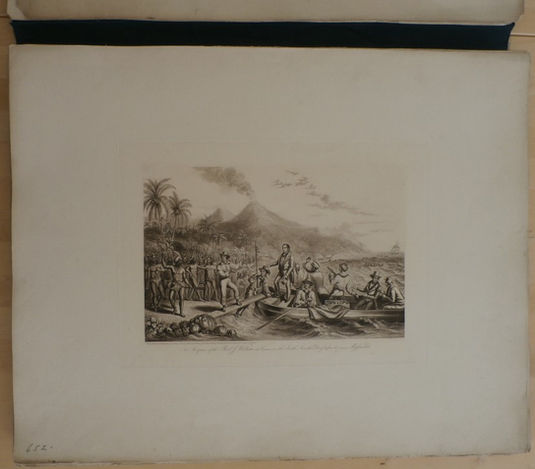
Frederick Mockler and the Mockler Portfolio of Baxter Prints
Click on images to show an enlargement in a new window
1) The outside cover 2) The title page and inner cover 3) A sample reprint from the Portfolio - The Reception of the Rev John Williams at Tanna 4) A close up showing the plate mark, the pressure of the steel plate pressed inro the paper and the 'orange peel effect' that usually denotes a Mockler reprint
Frederick Mockler is an important name in the history of Baxter print collecting. his father is said to have purchased prints from one of Baxter’s travelling sales in the early 1860’s (link 1) and at some time that collection came to him. In the late 19th Century he enlarged the collection with great vigour including a ‘trunk’ full of prints, colour trials and pulls quite possibly the remains of Baxter’s workshop when it closed.
The buying culminating in 1893 when Mockler approached Abraham Le Blond, now retired, and purchased all of Baxter plates and blocks in Le Blonds possession, along with hundreds of thousands of prints.
In 1894 Mockler published what came to be known as the ‘Mockler Portfolio’ being impressions from 67 or 68 of Baxter’s plates, although some were in fact from the plates of Le Blond himself, all the sheets were of very large size approx. 63.5 cm x 51 cm. Many that are found today outside of a portfolio have been trimmed.
The Folio titled “George Baxter’s Life and Works” also contained a list of Baxter’s works and details about Baxter, on some portfolio’s it is stated that ‘the present issue’ is limited to 100 copies. There may have been other editions but whatever they were not printed in great numbers and, as I write, there may only be one known copy that is complete, or possible still missing one sheet depending on the information you believe.
The impressions where taken in a dark grey / brown ink on thick dimpled quite soft paper. The plate mark, the indentation from the actual steel plate, is very noticeable but the dimples in the paper will usually be enough to identify a Mockler reprint. The paper surface is said to be like the skin of an orange.
A more detailed story of Mockler and his connection with the Baxter Plates will be written in due course and also his, possible dubious, association with the artefacts of the inventor of vaccinations Dr Edward Jenner.



